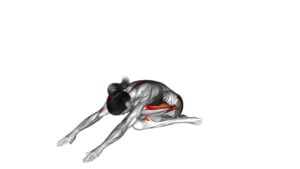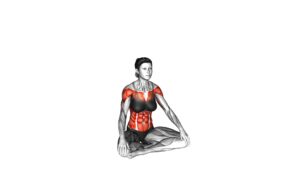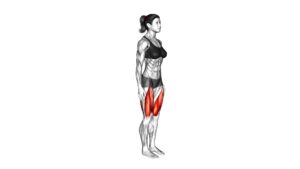90 to 90 Stretch (female) – Video Exercise Guide & Tips

Are you looking to improve your flexibility and strengthen your lower body? Look no further than the 90 to 90 stretch!
Watch This Exercise Video
In this video exercise guide, we'll show you how to properly perform this stretch, along with helpful tips and modifications for beginners.
If you're an experienced individual, we've got advanced variations for you too. Get ready to maximize your stretch and incorporate the 90 to 90 stretch into your routine for amazing results.
Let's get started!
Key Takeaways
- The 90 to 90 stretch improves flexibility and range of motion.
- It targets the hips, glutes, and lower back, alleviating tightness and discomfort in the hip area.
- Proper form and technique, such as maintaining a straight spine and relaxed shoulders, are important for maximizing the benefits and preventing injuries.
- Modifications and advanced variations can be used to tailor the stretch to individual needs and abilities.
Benefits of the 90 to 90 Stretch
To experience the full benefits of the 90 to 90 stretch, you should incorporate this exercise into your routine. This stretch targets the hips, glutes, and lower back, providing a multitude of benefits for your body. One of the main benefits is increased flexibility. Regularly performing the 90 to 90 stretch can improve your range of motion and help you move more freely. Additionally, this stretch can help alleviate tightness and discomfort in the hip area, especially after long periods of sitting or physical activity.
Another advantage of the 90 to 90 stretch is its ability to strengthen and stabilize the hips and core muscles. By engaging these muscles during the stretch, you can enhance their overall strength and stability, which is crucial for maintaining proper posture and preventing injuries.
To maximize the benefits of this stretch, it's important to keep a few tips in mind. First, make sure you warm up before attempting the 90 to 90 stretch. This can be done through light cardio exercises or dynamic stretches. Second, listen to your body and only go as far as feels comfortable. Avoid pushing yourself too hard, as this can lead to strain or injury. Lastly, remember to breathe deeply and relax into the stretch, allowing your muscles to release tension.
Proper Form and Technique
To perform the 90 to 90 stretch with proper form and technique, it's important to focus on the alignment of your body and engage the correct muscles. Proper form and technique are crucial for maximizing flexibility and avoiding common mistakes.
Start by sitting on the floor with one leg bent in front of you at a 90-degree angle and the other leg bent behind you at a 90-degree angle. Keep your spine straight and shoulders relaxed.
To engage the correct muscles, imagine a string pulling your head up towards the ceiling, lengthening your spine. This will help maintain proper alignment and prevent rounding of the back.
As you begin to stretch, focus on the muscles in the front of your hip and thigh. You should feel a gentle stretch in this area. Avoid pushing yourself too far or forcing the stretch, as this can lead to injury.
Common mistakes to avoid include rounding the back, hunching the shoulders, and leaning too far forward or backward. Remember to breathe deeply and relax into the stretch.
Modifications for Beginners
If you're a beginner, there are several modifications you can make to the 90 to 90 stretch to make it more accessible and comfortable for you. Here are some beginner modifications to consider when starting out:
- Use props: Place a bolster or folded blanket under your hips to provide support and lift. This will help alleviate any strain on your lower back and make the stretch more comfortable.
- Adjust the angle: Instead of keeping your legs at a 90-degree angle, start with a wider angle, such as 45 degrees. As you become more flexible, gradually work towards a 90-degree angle.
- Reduce the range of motion: If you find it challenging to bring both knees to a 90-degree angle, start by bending one knee at a time. Gradually work towards bringing both knees in at the same time.
Advanced Variations for Experienced Individuals
Ready to take your stretching routine to the next level?
In this section, we'll explore advanced variations of the to 90 stretch that are designed for experienced individuals.
These modifications will challenge your flexibility and take your stretches to the extreme.
Get ready to push your body to new limits and achieve even greater results in your stretching practice.
Challenging Modifications for Pros
You frequently challenge yourself with advanced variations of the to 90 stretch exercise. As an experienced individual, you're always seeking ways to push your limits and take your workout to the next level. Here are some challenging modifications and advanced variations to help you continue to progress:
- One-legged to 90 stretch: Lift one leg off the ground while performing the stretch to increase the intensity and challenge your balance.
- Weighted to 90 stretch: Hold a dumbbell or kettlebell in your hands to add resistance and increase the strength-building benefits of the exercise.
- Dynamic to 90 stretch: Instead of holding the stretch statically, perform a dynamic movement by smoothly transitioning between the starting position and the 90-degree angle, engaging your muscles throughout the entire range of motion.
Taking Stretches to Extremes
Once you have mastered the basic to 90 stretch, it's essential to consistently challenge yourself with advanced variations to further enhance your flexibility and strength.
Taking stretches to extremes is a way to push your limits and achieve extreme flexibility. However, it's crucial to approach these advanced variations with caution to prevent injuries.
One advanced variation is the split stretch, where you extend your legs into a full split position. This requires a high level of flexibility and should only be attempted if you're already comfortable with the to 90 stretch.
Another advanced variation is the scorpion stretch, where you kick your leg up and over your head, reaching towards your back. This stretch targets the lower back and hip flexors, but be careful not to overextend and strain your muscles.
Remember to always warm up properly before attempting these advanced variations and listen to your body to prevent injuries.
Tips for Maximizing the Stretch
To maximize the stretch in the to 90 stretch exercise, it's important to focus on proper form techniques. Ensure that your back is straight, your core is engaged, and your shoulders are relaxed.
Additionally, consider the duration and frequency of your stretching sessions, aiming for consistency and gradually increasing the time you hold the stretch.
Proper Form Techniques
Maximize the stretch by focusing on maintaining proper form throughout the to 90 stretch exercise. This will help you avoid common mistakes and reduce the risk of common injuries. Here are some tips to help you maintain proper form:
- Keep your back straight: Avoid rounding your back as you reach forward. This will ensure that you're targeting the correct muscles and preventing strain on your lower back.
- Engage your core: Activate your abdominal muscles to stabilize your spine and maintain balance during the stretch.
- Relax your shoulders: Avoid tensing your shoulders or hunching them up towards your ears. Keep them relaxed and down to allow for a deeper stretch.
By following these proper form techniques, you can maximize the effectiveness of the to 90 stretch.
Now let's move on to the next section to discuss the ideal duration and frequency for this exercise.
Duration and Frequency
To maximize the effectiveness of the to 90 stretch, it's important to consider the ideal duration and frequency for this exercise.
Maximizing results and preventing injuries are crucial goals when it comes to stretching. When it comes to duration, holding the stretch for 30 to 60 seconds is recommended. This allows the muscles to fully relax and lengthen. However, it's important not to push beyond your comfort level to prevent injuries.
As for frequency, aim to perform the to 90 stretch at least three times a week. This will help maintain flexibility and prevent muscle tightness. Consistency is key in order to see significant improvements in your flexibility over time.
Remember to always listen to your body and adjust the duration and frequency of the stretch accordingly.
Additional Stretching Exercises
Try incorporating other stretching exercises into your routine to enhance the effectiveness of the to 90 stretch. Here are some additional exercises that can help improve your flexibility:
- Standing Forward Fold: Stand with your feet hip-width apart, then slowly bend forward from your hips, reaching your hands towards the ground. Hold this position for 30 seconds to 1 minute.
- Seated Forward Bend: Sit on the ground with your legs extended in front of you. Slowly hinge forward from your hips, reaching towards your toes. Hold for 30 seconds to 1 minute.
- Butterfly Stretch: Sit on the ground with the soles of your feet together. Gently press your knees towards the ground as you lean forward. Hold for 30 seconds to 1 minute.
By incorporating these additional exercises into your routine, you can target different muscle groups and improve overall flexibility.
Now, let's explore how to incorporate the 90 to 90 stretch into your routine.
Incorporating the 90 to 90 Stretch Into Your Routine
To incorporate the 90 to 90 stretch into your routine, start by positioning yourself in the correct form. This stretch targets your hips, hamstrings, and lower back, providing several benefits for your flexibility and mobility.
To begin, sit on the floor with one leg extended straight in front of you and the other leg bent at a 90-degree angle, with the knee pointing out to the side. Keep your spine straight and engage your core.
Slowly lean forward from your hips, reaching your hands towards your extended leg. Remember to breathe deeply and relax into the stretch.
You can modify this stretch by using props such as a yoga block or a blanket under your hip to provide support and stability. Another modification is to use a strap or towel around your foot to help you reach further.
It's important to listen to your body and not push beyond your limits, as overstretching can lead to injury.
Frequently Asked Questions
Can the 90 to 90 Stretch Help With Improving Flexibility in Other Areas of the Body?
The 90 to 90 stretch is a great exercise for improving flexibility and body mobility. By specifically targeting the hips and legs, it helps to increase range of motion in these areas.
While it may not directly impact other parts of the body, the increased flexibility gained from this stretch can have a positive effect overall.
Incorporating this stretch into your routine can contribute to improved overall flexibility and body mobility.
Is It Necessary to Warm up Before Performing the 90 to 90 Stretch?
Before performing the 90 to 90 stretch, it's highly recommended to warm up your body. Warming up helps increase blood flow to your muscles, making them more flexible and less prone to injury. It also prepares your body for the stretching exercises by increasing your range of motion.
To perform the 90 to 90 stretch properly, sit on the floor with one leg bent at a 90-degree angle and the other leg extended straight out. Keep your back straight and lean forward, feeling the stretch in your hip and hamstring muscles.
Are There Any Variations of the 90 to 90 Stretch That Specifically Target Different Muscle Groups?
There are indeed variations of the 90 to 90 stretch that specifically target different muscle groups. By tweaking the angle of your legs or adding resistance, you can focus on engaging specific muscles such as the glutes, hamstrings, or hip flexors.
These variations allow you to customize the stretch to your individual needs and goals. Incorporating these variations into your routine can help you effectively target and strengthen different muscle groups.
How Often Should the 90 to 90 Stretch Be Performed to See Noticeable Improvements?
To see noticeable improvements in flexibility by doing the 90 to 90 stretch, it's important to perform it regularly. Consistency is key. Aim for at least three times a week, but if you can do it more often, even better!
Start with a comfortable intensity and gradually increase it over time to challenge your muscles and improve your flexibility. Be patient, as it may take a few weeks or even months to see significant improvements.
Keep practicing and you'll get there!
Are There Any Potential Risks or Precautions to Consider When Performing the 90 to 90 Stretch?
When performing the 90 to 90 stretch, it's important to be aware of the potential risks and take necessary precautions. Some potential risks include straining or pulling muscles if not done properly. To minimize these risks, make sure to warm up before attempting the stretch and listen to your body's limits.
Avoid pushing yourself too hard and stop if you feel any sharp pain or discomfort. It's always a good idea to consult with a professional before starting any new exercise routine.
Conclusion
In conclusion, the 90 to 90 stretch is a highly beneficial exercise for improving hip mobility and flexibility.
It can be modified for beginners and advanced individuals alike, and when performed with proper form and technique, it can help prevent injuries and enhance athletic performance.
Incorporating the 90 to 90 stretch into your routine can greatly contribute to overall fitness and well-being.
Remember to consult with a qualified fitness professional before starting any new exercise program.

Author
Years ago, the spark of my life’s passion ignited in my mind the moment I stepped into the local gym for the first time. The inaugural bead of perspiration, the initial endeavor, the very first surge of endorphins, and a sense of pride that washed over me post-workout marked the beginning of my deep-seated interest in strength sports, fitness, and sports nutrition. This very curiosity blossomed rapidly into a profound fascination, propelling me to earn a Master’s degree in Physical Education from the Academy of Physical Education in Krakow, followed by a Sports Manager diploma from the Jagiellonian University. My journey of growth led me to gain more specialized qualifications, such as being a certified personal trainer with a focus on sports dietetics, a lifeguard, and an instructor for wellness and corrective gymnastics. Theoretical knowledge paired seamlessly with practical experience, reinforcing my belief that the transformation of individuals under my guidance was also a reflection of my personal growth. This belief holds true even today. Each day, I strive to push the boundaries and explore new realms. These realms gently elevate me to greater heights. The unique combination of passion for my field and the continuous quest for growth fuels my drive to break new ground.







